Ocean Acidification: Facts and Implications for Marine Life
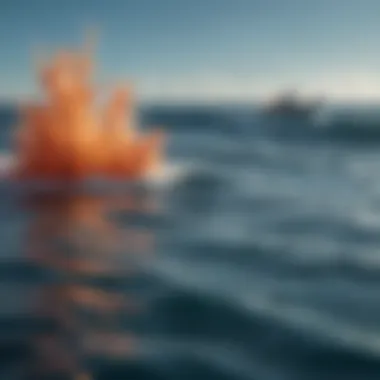
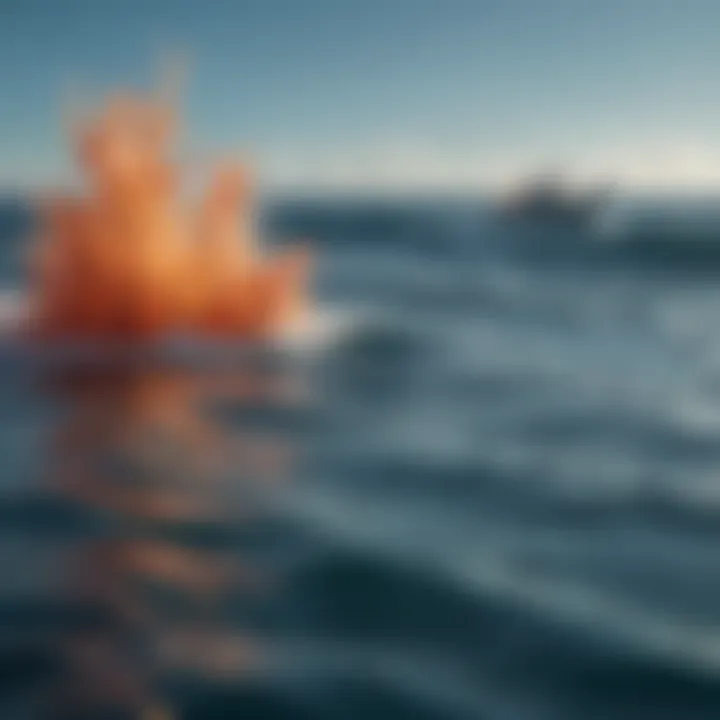
Intro
Ocean acidification is not just a term that gets tossed around in environmental conversations; it’s a reality that’s become increasingly pressing in recent years. This phenomenon occurs when carbon dioxide (CO₂) from the atmosphere dissolves in seawater, leading to a series of chemical reactions that ultimately lower the pH of the ocean. While it might sound like a technical matter confined to the pages of scientific journals, its implications are far-reaching, stretching from marine life to global economies.
Take a moment to digest this: the ocean has absorbed roughly 30% of the CO₂ emitted by human activities since the beginning of the Industrial Revolution. This absorption is not without consequence—it's changing the very chemistry of our seas, putting immense pressure on wildlife and ecosystems that are already strained by overfishing, habitat loss, and climate change. The changes brought about by higher acidity levels threaten coral reefs, shellfish, and many other marine organisms that are crucial for ecological balance and human livelihoods alike.
Understanding the intricacies of ocean acidification involves digging into various factors, from the disproportionate impact on different marine species to how coastal communities are affected. As we explore the chemical processes and the far-reaching effects of this environmental challenge, it is essential to grasp that knowledge equips us to address these pressing issues. The quest for solutions begins with awareness, and by dissecting this phenomenon, we can both reflect on our life choices and consider actionable steps toward mitigation. Kudos to anyone committed to grappling with this, because it's gonna take a collective effort to combat it.
In this article, we will unpack the layers of ocean acidification, unveiling the contributing factors to its rise and synthesizing the information that portrays its impact on marine ecosystems. Moreover, we’ll shine a light on potential strategies for mitigating its effects and underscore the essential role each of us plays in the narrative of restoration. Let's dive deeper into this perplexing subject and explore not only the facts but also the stories behind them that drive the urgency of informed action.
Preamble to Ocean Acidification
Ocean acidification is not just some science jargon tossed around at conferences; it’s a real and pressing issue that demands our attention. With the oceans acting as the planet’s sink for carbon dioxide, the increasing levels of this gas are fathering a chain reaction that affects marine ecosystems and, consequently, humanity's survival. Understanding ocean acidification is essential because the health of our oceans directly correlates with the quality of life on land.
Experts believe that changes brought on by ocean acidification can have long-term consequences for marine life, from the biggest whales down to the humblest plankton. When we take a closer look at how rising acidity levels disrupt the delicate balances within these systems, it becomes clear that fishermen, coastal communities, and even non-water sports enthusiasts alike are at the mercy of these changes.
Why Should We Care?
- Ecosystem Health: Acidification impacts coral reefs, which are vital habitats for millions of marine species.
- Food Security: Fisheries are adjusting due to altered marine food webs, leading to consequences for global food supplies.
- Economic Ties: Many coastal economies depend on the fishing and tourism industries that flourish when marine ecosystems are healthy.
In short, the importance of examining this topic cannot be overstated. As we move forward, we should gear our minds towards understanding not only what ocean acidification is, but also how it has evolved historically—and why recognizing those trends matters now more than ever.
Defining Ocean Acidification
Ocean acidification refers to the process where the pH levels of the ocean decrease due to the absorption of carbon dioxide from the atmosphere. When CO2 enters ocean waters, it reacts with water to form carbonic acid, which subsequently breaks down into bicarbonate and hydrogen ions. This reaction leads to a drop in pH, making the ocean more acidic. In simpler terms, what goes up in the form of greenhouse gases doesn’t just vanish; it gets absorbed and changes the very essence of our oceans.
This phenomenon can seem abstract, but for species reliant on calcium carbonate, such as corals and shellfish, the implications are very tangible. As acidity levels rise, these organisms struggle to maintain their structures, leading to a ripple effect across the ecosystem.
Key Points to Note:
- Ocean acidity levels have increased by approximately 30% since the beginning of the industrial era.
- The current rate of change far surpasses natural fluctuations that have occurred over millennia.
Historical Context and Trends
To truly grasp how we’ve arrived at this critical junction, a look back through history reveals some alarming trends. The past century has witnessed an unprecedented increase in carbon emissions, primarily from burning fossil fuels. This practice has not only warmed our planet but has also dramatically altered the chemical composition of ocean waters.
- Pre-Industrial Revolution: Before the late 1700s, ocean pH averaged around 8.2.
- Present Day: Recent data suggests that this average has fallen to about 8.1, indicating a significant shift.
This decline, while appearing slight, represents a massive change in ocean chemistry. Projections suggest that if current emission trends continue, ocean pH could drop to about 7.8 by the end of the century, which could have catastrophic impacts on marine life.
"The only way to effectively tackle ocean acidification is through immediate, collective actions. Time is of the essence."
Examining past data allows us to understand patterns and predict future scenarios. The historical context is not merely for reflection; it's a critical foundation for our collective understanding and subsequent action against this emerging crisis. Each decade unfolds like a chapter in a novel we didn’t ask to read, and it’s our responsibility to rewrite it before it ends in tragedy.
The Chemical Basis of Ocean Acidification
Understanding the science underlying ocean acidification is crucial for grappling with its implications on marine ecosystems. This isn’t just about chemistry; it’s a window into a pressing environmental issue. The ocean plays a pivotal role in carbon storage and, by extension, climate regulation. When we burn fossil fuels, carbon dioxide (CO2) enters the atmosphere, and a significant portion of this gas finds its way into our oceans, resulting in an acidification process that stirs alarm among ecologists and marine enthusiasts alike. The repercussions of these chemical changes ripple through our oceans, impacting biodiversity and leading to broader ecological shifts.
Carbon Dioxide and Its Role
At the heart of ocean acidification is carbon dioxide. As mentioned, when we emit CO2 through our activities, about 30% of it is absorbed by seawaters, resulting in a series of chemical reactions that alter the ocean's pH levels. As CO2 diffuses into seawater, it reacts with water molecules to form carbonic acid. This is where things take a turn:
- Carbonic Acid Formation: CO2 + O ↔ CO3
- Dissociation of Carbonic Acid: CO3 ↔ HCO3^- + H^+
- Additional Dissociation: HCO3^- ↔ CO3^2- + H^+
The increase in hydrogen ions (H+) lowers the pH of seawater, making it more acidic. This is no trivial matter. A more acidic ocean can hinder the ability of marine organisms, such as corals and shellfish, to form calcium carbonate structures. Think of it this way: just like a sculptor needs the right materials to create a masterpiece, marine creatures require stable conditions to thrive.
Despite the inherent complexities of these reactions, the outcomes are direct and concerning. A more acidic environment poses challenges for marine species, especially those relying on shells and exoskeletons. For instance, organisms like pteropods and oysters are particularly susceptible to these changes, and they are crucial to the food chain, serving as nourishment for larger fish.
Chemical Reactions in Seawater
The chemistry of seawater is dynamic, teeming with life-sustaining interactions, but the introduction of excess CO2 shifts this balance. The seawater's natural buffering system, which helps maintain relatively stable pH levels, is under siege. The resultant reduction in carbonate ions (CO3^2-) diminishes calcium carbonate saturation.
When less calcium carbonate is available, the effects cascade through marine ecosystems:
- Coral Reefs: Coral polyps struggle to build their calcium carbonate skeletons, threatening the expansive biodiversity these reefs support.
- Shellfish Populations: Species like clams and mussels experience thinner shells, making them more vulnerable to predators.
"Ocean acidification is the villain in the story that redefines marine life as we know it, impacting everything from individual species to entire ecosystems."
So, it's clear that the chemical transformations in seawater provoked by absorbed carbon dioxide do not occur in a vacuum. They're a part of a more systemic issue that jeopardizes marine life, fisheries, and the economies that depend on them. By comprehensively understanding these reactions and their consequences, we position ourselves better for tackling the broader implications of ocean acidification for our planet's health.
Contributing Factors to Ocean Acidification
Understanding the contributing factors to ocean acidification is essential because they provide insight into how human activities and natural events interplay within marine ecosystems. The ongoing shifts in ocean chemistry do not happen in isolation; they stem from various sources and behaviors, predominantly centered around human influence. This complexity can enlighten efforts for mitigation and adaptation, as recognizing the roots of the problem is the first step toward healing the oceans.
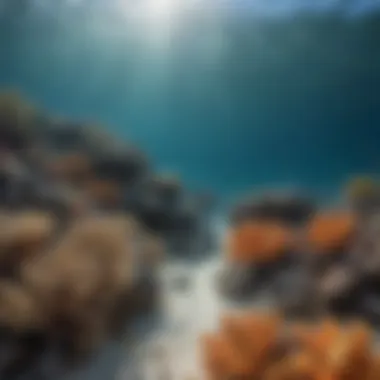

Anthropogenic Emissions
When we talk about anthropogenic emissions, we can’t overlook the elephant in the room: carbon dioxide released from burning fossil fuels. This practice sends a hefty amount of CO2 into the air, most of which eventually finds its way to the ocean. Once dissolved in seawater, CO2 reacts with water molecules, causing chemical changes that lead to increased acidity. It’s like a slow poison spilling into the ocean, posing threats to marine life.
The statistics are staggering. According to various studies, the oceans have absorbed about 30% of the emitted CO2 since the industrial era. This isn't just a drop in the bucket; it's an oceanic level change that our marine ecosystems are struggling to withstand. Fish, corals, and other marine organisms are not just bystanders in this story; they are feeling the heat firsthand. If trends continue, whole ecosystems may collapse, affecting biodiversity and fisheries vital for global food security.
Deforestation and Land Use Changes
Moving beyond the atmosphere, we must address land use changes, notably deforestation. When forests are cleared, carbon which has been sequestered over decades is released back into the atmosphere. Forests serve as vital carbon sinks, absorbing CO2, and without them, the excess carbon exacerbates the acidification process.
Additionally, land use changes often result in increased runoff of pollutants into our oceans. Essential nutrients, while vital at balanced levels, can contribute to harmful algal blooms when present in excess—leading to dead zones where marine life can’t thrive. So really, deforestation does double duty in the context of ocean acidification: it directly contributes through emissions and indirectly through pollution.
Natural Contributions vs. Human Impact
Interestingly, the ocean’s natural processes also influence acidity levels. For instance, volcanic eruptions release carbon compounds that can elevate ocean acidity in localized areas. However, when putting this in perspective, it's essential to recognize the scale of human impact compared to these natural contributions.
Research indicates that human-induced changes dwarf natural events. The global carbon cycle, once beautifully balanced, has been thrown into disarray by industrial activities. While there’s an inherent ecological resilience present in marine systems, it’s becoming increasingly difficult for organisms to adapt to the rapid pace at which changes are occurring. Rather than trying to play catch up, it’s high time we address the driving forces behind ocean acidification to restore equilibrium to our marine environments.
"Understanding the delicate balance of our oceans and how different factors contribute to their health is crucial for ensuring their survival for future generations."
In essence, recognizing the interplay between anthropogenic emissions, land use changes, and the bounds of natural contributions allows us to strategize better. Whether it’s through reducing carbon outputs, restoring forests, or protecting coastal habitats, every action counts. In this intricate dance of cause and effect, it’s imperative to hold ourselves accountable and work towards sustainable practices.
Effects on Marine Life
The issue of ocean acidification carries grave consequences for marine life. With rising carbon dioxide levels, the chemistry of ocean waters changes, leading to various detrimental effects on organisms inhabiting these ecosystems. The intricate interconnections within the marine environment mean that disruptions affect not only individual species but can also impact broader ecological systems and the communities that depend on them. Understanding how ocean acidification affects marine organisms is crucial for conserving biodiversity and the social structures built around marine resources.
Impact on Coral Reefs
Coral reefs, often referred to as the "rainforests of the sea," provide habitat for a vast array of marine species. These structures are built from calcium carbonate, which corals secrete. However, as carbon dioxide levels rise, the pH of ocean water decreases, leading to a more acidic environment. This increased acidity hampers the ability of corals to form their calcium carbonate skeletons.
Notably, coral bleaching becomes more prevalent under acidified conditions. When stressed by changes in temperature and acidity, corals expel the symbiotic algae living in their tissues, leading to a white appearance. If these stresses continue, it can ultimately result in coral die-off, which would drastically alter the marine landscape. About 25% of marine life depends on coral reefs at some point in their life cycle, which shows how their decline could have cascading effects throughout the ecosystem.
"Healthy coral reefs are vital to maintaining not only biodiversity but also the economic health of coastal communities who rely on fishing and tourism."
Effects on Shellfish and Marine Fauna
Shellfish, including oysters, clams, and mussels, rely on calcium carbonate to form their shells. With ocean acidification, the availability of carbonate ions diminishes, which is essential for their shell-building processes. For example, studies have shown that young oysters are particularly sensitive; a decrease in shell size leads to higher susceptibility to predation and disease. This reduction is not just a problem for the shellfish themselves, but it extends to the fishing industries that depend on these organisms.
Moreover, marine fauna such as crabs and certain fish species are also affected. They often exhibit altered behavior when exposed to increasingly acidic waters, which can lead to reduced foraging efficiency and altered predator-prey dynamics. One can see how critical these impacts are, creating a ripple effect through ecosystems.
Disruption of Food Chains
The impacts of ocean acidification are not confined to individual species; they incite significant disruptions within the food web. Phytoplankton, the foundation upon which many marine food chains are built, may be sensitive to changes in pH levels. A decline in phytoplankton populations could mean less food available for zooplankton, which in turn affects fish and larger predators.
Given that many coastal communities rely on fish as a primary source of protein, disruptions at this foundational level can jeopardize food security. The potential reduction in fish stocks could lead to socioeconomic challenges as communities struggle to adapt to dwindling resources.
In summary, the effects of ocean acidification on marine life are profound. From the deterioration of coral reefs to the challenges faced by shellfish and the broader implications for food chains, these changes highlight the urgency of understanding and addressing ocean acidification in our ever-changing world.
Societal Implications of Ocean Acidification
The societal implications of ocean acidification resonate widely, affecting numerous aspects of human life and the environment. As we attempt to navigate the complexities of our modern world, understanding these impacts becomes essential. Ocean acidification isn't just a scientific term; it connects directly with our livelihoods, food sources, and coastal communities. The far-reaching implications can alter how societies function and interact with marine resources.
Impact on Fisheries and Global Food Security
Fisheries are a cornerstone of food security for millions around the globe. With ocean acidification, the core issue at hand is the disruption it creates within marine ecosystems. Fish stocks, especially those that rely on shellfish and coral reefs for sustenance, are at a high risk. Rising acidity affects the carbonates that these marine organisms depend on to build their shells and skeletons. This can lead to a decrease in shellfish harvests—think oysters and clams—ultimately sending shockwaves through the fishing industry.
Consider that global production for shellfish accounts for billions in revenue. Losses in these sectors can directly correspond to rising prices at seafood markets, tightening the screws on consumer spending.
"Rising ocean acidity is a silent crisis that could disturb not only our oceans but also our plates."
Moreover, to paint a clearer picture, let’s break down how fisheries might be affected:
- Stock Decline: Important fish species could see their populations dwindle due to habitat loss.
- Economic Shifts: Fishermen might need to shift their catches or even relocate, causing disruptions to local economies.
Effects on Coastal Communities
Life in coastal communities revolves around the sea. From tourism to fishing, these societies depend on marine ecosystems' health. When ocean chemistry changes, whole livelihoods can be put at stake. Picture seaside towns where fishing boats come in with lighter hauls, or vacations that lose their charm as once-thriving reefs fade into silent graveyards. Not only does such a shift apply pressure on local economies, but it also transforms social structures. For instance, communities that celebrate their fishing culture might find it dissolving beneath the tide, leaving folks scrambling for alternatives.
- Social Impacts: With fishermen facing increased uncertainty, mental health challenges could arise as incomes sink.
- Tourism Fallout: Affected coral reefs mean less attraction for snorkelers and divers, leading to dwindling tourism revenues.
Economic Consequences
The financial ramifications are stark. Many businesses intertwine with ocean health directly or indirectly: restaurants, hotels, and local shops. As marine economies begin to falter, the trickle-down effect can affect many layers of society. Loss of jobs in the fishing and tourism sectors can deal devastating blows to families.
It's also worth noting that governments might bear unforeseen costs. Here’s a glimpse of potential economic consequences of ocean acidification:


- Increased Management Costs: More resources into monitoring and mitigating ocean health.
- Loss of Ecosystem Services: As the oceans grow more acidic, critical services—like carbon storage and coastal protection from storm surges—diminish, leading to increased vulnerability and ongoing expenditures to compensate.
Mitigation Strategies and Solutions
Mitigation strategies and solutions form a pivotal component in addressing the looming crisis of ocean acidification. Without effective actions in place, the implications for marine ecosystems, economies, and ultimately, human health, could spell disaster. It's not just about curtailing emissions; it's about fostering a holistic approach that brings together various stakeholders, from governments to individual citizens. In this section, we'll explore specific strategies that can help mitigate the effects of ocean acidification.
Reducing Carbon Emissions
One of the foremost strategies for combating ocean acidification is to reduce carbon emissions at their source. The burning of fossil fuels remains the largest contributor to the increasing levels of carbon dioxide in the atmosphere. Embracing renewable energy sources like wind, solar, and hydroelectric power presents a promising path forward. Transitioning from coal-powered plants to cleaner alternatives can significantly lower the carbon footprint.
Corporate responsibility is also key. Many businesses are beginning to adopt practices geared toward sustainability, such as using energy-efficient technologies or implementing carbon offsets. The push for electric cars is another significant step in the right direction.
It's essential to involve state and local governments in these efforts — incentivizing businesses for reducing emissions can create a snowball effect in the community. Everyone has a role to play, and every little bit helps.
Conservation Efforts for Marine Ecosystems
Conservation methods serve as another cornerstone of mitigation strategies. Protecting and restoring important marine habitats such as coral reefs and mangroves can help foster resilience among marine species.
- Marine Protected Areas (MPAs) have gained traction in recent years. By creating designated zones where fishing is restricted or banned, we allow ecosystems to regenerate naturally. Studies suggest that these areas can enhance biodiversity and improve fish stocks.
- Habitat restoration involves actions like replanting seagrass or restoring coral reefs, which improve local water quality and help combat acidification.
The positive impact of these conservation efforts extends to local communities as well. Healthy marine ecosystems sustain fisheries, which in turn supports livelihoods and food security. A thriving ecosystem is essentially a safety net for coastal communities.
Community Engagement and Education
Community engagement is vital. The knowledge gap must be bridged; that’s where education comes into play. Awareness campaigns can mobilize citizens to make informed choices about their carbon footprints.
- Workshops and seminars can teach local fishermen sustainable practices like selective fishing methods, which not only preserve marine life but also ensure future catches. Individual actions, when multiplied across communities, can lead to significant changes.
- Online platforms and social media are powerful tools for advocacy. Activists and organizations can share information quickly, raising awareness on the consequences of inaction. Social media campaigns that focus on simple, actionable changes individuals can make — like reducing plastic use — can build community consensus and collective action.
“Education is the most powerful weapon which you can use to change the world.” – Nelson Mandela
It’s time to leverage this weapon for ocean health. By combining grassroots efforts with global initiatives, we can create momentum that compels policymakers to act.
In summary, while reducing carbon emissions, conserving marine ecosystems, and engaging communities are distinct strategies, together they weave a comprehensive response to ocean acidification. Transitioning from talk to action is essential for the future of our oceans, livelihoods, and the very ecosystem upon which we all rely.
The Role of Policy in Addressing Ocean Acidification
Ocean acidification is not just a scientific issue; it is a multi-faceted problem that requires our collective action at various levels. The role of policy in mitigating this phenomenon is crucial. Effective policies can pave the way for protective measures that help marine ecosystems adapt to changing conditions. These policies range from local regulations to international agreements and can have a long-lasting impact on the health of our oceans.
Rather than piecemeal efforts, a coordinated approach is beneficial. Policy frameworks that bring together countries, states, and local communities can foster collaboration on research, data collection, and best practices. This enhances not only our understanding of ocean acidification but also our ability to combat it.
Moreover, effective policies can stimulate innovation and investment in cleaner technologies. When the government sets standards, it gives companies incentives to investigate new methods that will help reduce carbon emissions. This synergy between regulatory measures and private initiative is key to addressing climate change holistically.
"The solutions to combat ocean acidification will not come from science alone; they require thoughtful governmental policies that engage communities and industries alike."
In addition, public awareness campaigns as part of policy can engage water sports enthusiasts and outdoor adventurers, groups that greatly depend on healthy ocean systems. By emphasizing the importance of a balanced ecosystem, policymakers can inform this audience on the pressing nature of ocean health.
International Agreements and Cooperation
When we talk about tackling ocean acidification on a global scale, international agreements play a pivotal role. Various treaties and accords establish frameworks for reducing greenhouse gas emissions, which are the primary culprit behind increasing acidification levels. For example, the Paris Agreement aims to limit global warming and subsequently cut carbon dioxide output. Countries that commit to these international standards can create a ripple effect, encouraging others to take action.
These agreements often involve regular assessments and updates, keeping nations accountable for their contributions toward reducing ocean acidification. Through collaborative efforts, countries can share research findings, innovative technologies, and best practices that help address this environmental challenge.
- Strengthening Global Cooperation: Nations working hand in hand to create solutions, financial aid for developing countries, and shared technological advancements.
- Monitoring Commitments: Rigorous tracking of emissions and ocean health metrics can ensure that the commitments made are normatively followed.
National Commitments and Action Plans
On a national level, governments need to craft commitments that translate these international agreements into actionable plans. This means localizing global policies, which could vary dramatically depending on a nation’s resources, infrastructure, and ecological needs. For instance, a country with extensive coastline and marine biodiversity has different focus areas compared to a landlocked nation.
Successful action plans should include specific targets for emission reductions, monitoring strategies, and adaptive measures that prioritize vulnerable marine ecosystems. Programs could be structured to incentivize businesses in carbon-neutral practices or to promote sustainable fishing practices among coastal communities.
- Implementation of Local Regulations: These might include stricter emissions laws or enhanced fishing quotas to protect marine life.
- Engagement with Indigenous Communities: Indigenous knowledge can provide valuable insights and practices that enhance marine health.
In this ongoing battle against ocean acidification, robust policy frameworks at both national and international levels serve as the backbone for success. This cooperation will ensure a future for our oceans while promoting awareness and understanding amongst communities reliant on marine resources.
Scientific Research and Monitoring
Scientific research and monitoring play critical roles in understanding the phenomenon of ocean acidification. As we navigate through a loomy future where carbon dioxide levels seem to be on a steady climb, it becomes increasingly vital to track the impacts of these changes on ocean chemistry. The delicate balance of marine ecosystems hinges on this understanding, offering a guiding light for policymakers, industries, and individuals alike.
This ongoing research provides us with the data needed to understand how increased acidity is altering the very fabric of marine life. Scientists utilize sophisticated methodologies—ranging from laboratory experiments to in-situ measurements—that highlight the intricacies of chemical reactions occurring in seawater. Each study brings to the forefront new findings about dire changes that affect not just coral reefs but the entire oceanic web, thereby alerting us to potential ecological collapse.
Moreover, monitoring ocean acidity over time is crucial to identify trends and predict future scenarios. This data allows for formulating community and governmental strategies that tackle this looming crisis effectively, ensuring that actions are based on solid scientific evidence rather than mere speculation. In short, stringent and well-structured scientific endeavors pave the way for informed decision-making impacting marine conservation and sustainability.
Key Studies and Findings
Numerous studies have illuminated the nuances of ocean acidification, emphasizing its urgency and relevance. For instance, a landmark study conducted by researchers from the National Oceanic and Atmospheric Administration (NOAA) revealed alarming rates of pH decline in coastal waters, affecting multiple communities of marine organisms. This study highlighted how vulnerable species like Pinctada margaritifera, the pearl oyster, are experiencing significant physiological stress under current carbon dioxide levels.
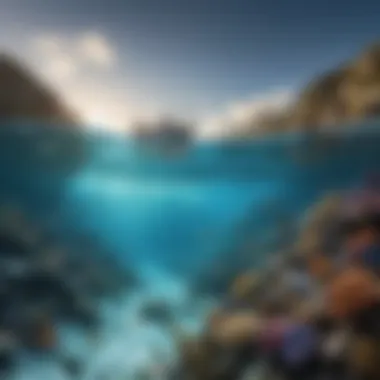
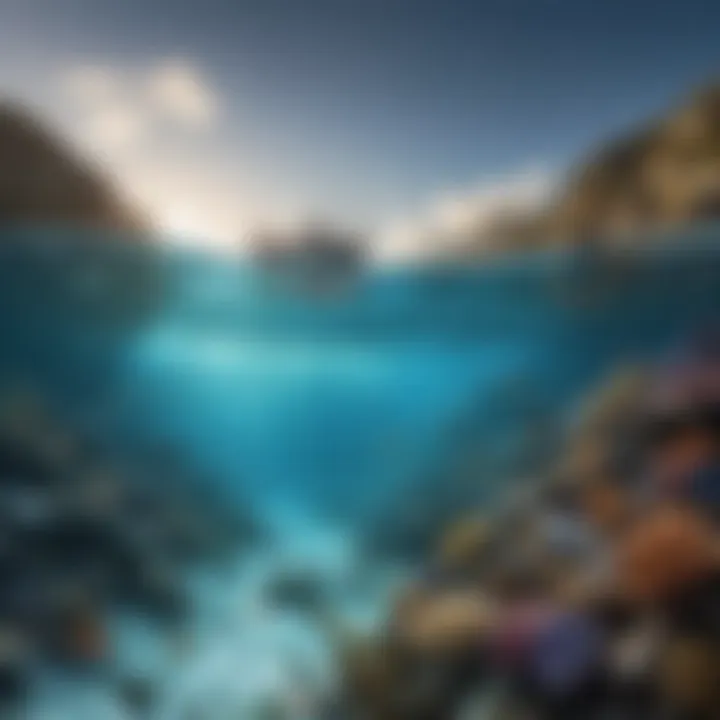
Another important research effort, published in Nature Climate Change, focused on the effects of increased carbon absorption on coral reefs. The findings indicated that even modest increases in carbonic acid could lead to severe structural damage in reefs, jeopardizing entire marine biodiversity linked to these habitats.
These studies serve as a wake-up call, pushing the scientific community and stakeholders to take ocean acidification seriously. As the data continues to evolve, it closes gaps in our understanding and underscores the need for swift action.
Technology in Ocean Monitoring
The advances in technological tools for ocean monitoring are both exciting and essential. For instance, autonomous underwater vehicles (AUVs) have become invaluable assets in real-time data collection. These nimble machines can traverse the ocean depths, capturing in situ measurements of pH, temperature, and other vital chemical properties, making it easier than ever to gather comprehensive datasets.
In addition, satellite technology is increasingly being deployed to monitor sea-surface temperatures and chlorophyll concentrations, providing insights into bio-geochemical cycles in relation to acidification. This tech-driven approach allows researchers to gather extensive data over vast areas that would otherwise be infeasible to monitor.
Beyond observational technologies, predictive modeling software plays a crucial role in risk assessment. By utilizing historical data and current trends, models can forecast potential scenarios based on varying levels of carbon emissions, thus aiding in informed policy formulations.
The integration of these advanced technologies ensures that we are not merely observers in the face of a growing crisis but proactive participants carving a path towards solutions.
"Continuous research and monitoring are not just luxury pursuits; they are necessities for nurturing ocean health and sustainability."
Individual Actions and Public Awareness
Understanding ocean acidification isn’t just for scientists in lab coats or environmental activists hoisting signs at rallies; it’s a concern that should tug at the heartstrings of every individual. Public awareness surrounding this pressing issue paves the way for constructive individual actions. When more people grasp the seriousness of ocean conditions, they are empowered to make informed choices. From everyday lifestyle adjustments to larger collective movements, each step contributes significantly. The ocean isn't merely a backdrop for summer vacations; it's a vital system that directly impacts our planet and, consequently, our lives.
How Individuals Can Contribute
Every small action counts. Here are a few multiplied suggestions on how one can help combat ocean acidification:
- Reduce Carbon Footprint: Use public transportation or bike when possible. Switching to energy-efficient appliances can cut down emissions.
- Support Sustainable Products: Opt for organic and sustainably sourced goods. Check labels for certifications that ensure environmentally friendly practices.
- Educate Yourself and Others: Diving into research or reading books about ocean health can arm you with facts. Sharing this knowledge can create a ripple effect, sparking conversations within your community.
- Participate in Local Clean-Ups: Organizations frequently hold beach or river clean-ups. Those volunteer days aren't just about cleaning; they're about building community and raising awareness.
Overall, it’s about cultivating a mindset where environmental-consciousness becomes second nature.
Advocacy and Activism in Ocean Health
When individuals rally around ocean health, the power of grassroots activism comes to play. The spark of a few passionate voices can ignite change. Whether it’s signing petitions, joining advocacy groups, or even just attending local council meetings, these activities amplify pressure on leaders to take action against ocean acidification.
- Use Social Media: Platforms like Facebook or even Reddit can be channels for spreading information. Share articles, or organize awareness campaigns to keep the conversation rolling about ocean health.
- Lobby for Change: Reach out to policymakers to express your concerns. Letter-writing campaigns can make a big difference. Research shows that constituents who actively engage often wind up influencing legislative decisions.
- Engage in Local Initiatives: Understand your local government programs focusing on conservation. Being part of those initiatives makes individuals energized and should inspire collective action.
For more insights and updates, check out resources like Wikipedia or Britannica which delve deeper into the scientific intricacies of this crucial issue.
Future Outlook and Predictions
The future of our oceans is hanging in balance as we churn through the age of climate change. Understanding what lies ahead in ocean chemistry and the ecosystem becomes paramount for everyone, especially for water sports enthusiasts and outdoor adventurers who rely on healthy marine environments.
Projected Trends in Ocean Chemistry
Ocean chemistry is poised to undergo radical shifts in this century, primarily driven by factors such as rising carbon dioxide concentrations and warming temperatures. Studies suggest that the world's oceans have absorbed about 30% of the CO2 released by humans since the advent of the Industrial Revolution. This absorption is not without consequence. As CO2 levels increase, we can expect to see declines in pH levels—a process that translates into higher acidity.
"Every drop of CO2 that enters the ocean changes its makeup, and this ongoing alteration could lead to unforeseen challenges for marine life and ecosystems."
Experts predict that by 2100, ocean acidity could rise by up to 150% compared to pre-industrial levels. Some notable trends expected to unfold include:
- Decreased carbonate ion concentration: This shift affects organisms like corals and shellfish, which depend on carbonate for building their shells and skeletons.
- Altered nutrient cycles: An increase in acidity disrupts nutrient processing, impacting food availability for various marine species.
- Expanded dead zones: As temperatures and acid levels climb, areas with lower oxygen concentrations may increase, challenging fish populations and disrupting local fisheries.
It's clear these trends necessitate urgent investigation and action.
Potential Impact on Marine Biodiversity
Diverse marine biodiversity underpins the health of ocean ecosystems. However, rising acidity threatens the delicate balance of these systems. Certain species may adapt, but many others will struggle to survive under changing conditions.
- Coral reefs, often termed the rainforests of the sea, are particularly at risk. Ocean acidification weakens their structure and resilience, leading to widespread bleaching, which jeopardizes the myriad of creatures that depend on reefs for habitat.
- Shellfish like clams, oysters, and some species of plankton face daunting challenges in shell formation. Predicted reductions in shellfish populations could ripple through seafood markets and impact countless communities reliant on fishing.
- Food webs may experience disruptions as the foundational species like plankton are affected, thereby altering the availability of prey for fish and predators further up the food chain.
Maintaining biodiversity in our oceans is not just about protecting marine species; it translates into economic stability and resilience against climate change fallout.
Only by bridging the gap between scientific understanding and public awareness can we hope to engage communities in action against ocean acidification. By casting a wider net for educational initiatives and including the experiences of enthusiasts in conservation efforts, we may craft a more sustainable future for oceans and the adventures they hold.
Closure
The conclusion of this exploration on ocean acidification serves as a crucial recap, underscoring the pressing need to grasp the intricacies and ramifications of this phenomenon. Understanding ocean acidification is not just an academic exercise; it is vital for the survival of marine ecosystems and the livelihoods that depend on them. The insights gained through this study lay a foundation for informed discussions and actionable strategies, ultimately highlighting how interconnected our environments and economies truly are.
Summary of Key Points
To encapsulate, several essential elements deserve emphasis:
- Defining the Issue: Ocean acidification stems primarily from increased carbon dioxide concentrations in the atmosphere, with oceans absorbing a significant portion, thereby altering their chemistry.
- Historical Context: A look back reveals how industrial activities since the 18th century have accelerated these changes, placing unprecedented stress on marine life.
- Effects on Biodiversity: The impact on coral reefs, shellfish, and overall marine diversity cannot be overstated, with many species struggling to adapt to the changing chemistries of their habitats.
- Society’s Role: Our daily actions, from carbon emissions to resource consumption, directly feed into this issue. Coastal communities face not only ecological challenges but economic consequences as well.
- Mitigation and Adaptation: Strategies for reducing our carbon footprint, preserving marine ecosystems, and community engagement are critical in mitigating future impacts.
- The Importance of Policy: Local, national, and international cooperation is essential in creating frameworks that can effectively address the challenges posed by ocean acidification.
By dissecting these points, a clearer picture emerges, informing stakeholders about the path forward to tackle ocean acidification.
Call to Action
Now is not the time for complacency. It’s imperative for individuals, emphasizing their capacity for change, to recognize their potential impact. Here are some actionable steps:
- Educate Yourself and Others: Knowledge is the first step to action. Understanding how ocean acidification works enables better advocacy.
- Reduce Carbon Emissions: Whether it's adopting cleaner energy solutions or decreasing reliance on fossil fuels, individuals can reduce their carbon footprint significantly.
- Engage with Local Initiatives: Get involved with organizations focused on marine conservation. Whether it’s beach clean-ups or educational programs, your participation makes a difference.
- Support Policies That Matter: Vote for and advocate policies at local and national levels that prioritize environmental protection and climate action.
- Share Information: Use social media platforms like Facebook or Reddit to share insights and raise awareness. Discussions can spark interest and inspire others to act.
By taking these steps, everyone can contribute to the fight against ocean acidification. The responsibility lies with each one of us to ensure a healthier ocean for future generations.















